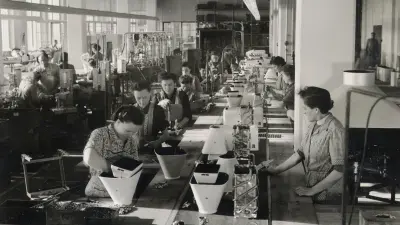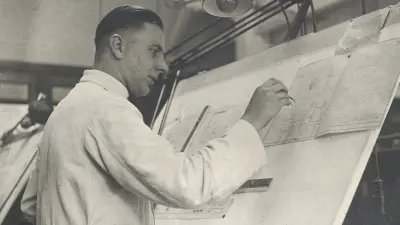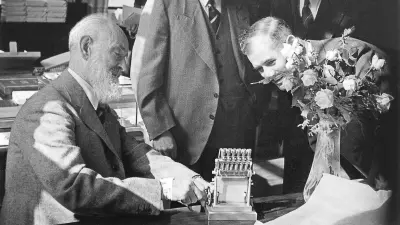Design in thermotechnology — now and then
Innovative collaboration at Junkers and Bosch Home Comfort

For Hugo Junkers, close collaboration between businesses and universities was always a win-win situation. That’s why it was a natural step for him to take on a position as professor of thermodynamics just two years after founding his company. Junkers & Co. GmbH employees also acted on this idea and developed innovative solutions and modern forms of presenting Junkers products in partnership with the Staatliches Bauhaus art school.
In 1923, Germany was in the midst of hyperinflation. Those who didn’t spend their wages as soon as they received them could barely afford to buy anything just a couple of days later. But, even in these turbulent times, there were still institutions courageous enough to drive change and innovation. One of them was the Staatliches Bauhaus art school, which presented itself to the public for the first time with an extensive exhibition. Junkers & Co. GmbH, the predecessor to what is now the Bosch Home Comfort division, was a major supplier of heating technology and hot-water solutions with its state-of-the-art products.
Staatliches Bauhaus

Bauhaus: Revolutionary art school
The Staatliches Bauhaus, known today mostly as Bauhaus, was an art school founded in Weimar in 1919. It existed for just 14 years, but became the most important school of architecture, design, and art of the 20th century. It was established with the aim of bringing together the areas of architecture, design, and art, which had previously been taught at separate academies.
Photo: © Aufbacksalami - Eigenes Werk, CC BY-SA 4.0, https://commons.wikimedia.org/w/index.php?curid=73392906
Collaboration between Junkers and the Staatliches Bauhaus
Walter Gropius, the founder of the Staatliches Bauhaus in Weimar, and Hugo Junkers had a close relationship and engaged in lively discussions. Junkers also took his employees to Bauhaus events, and Bauhaus artists had the opportunity to visit Junkers plants. So it is not surprising that Junkers took the opportunity to present his innovative products at the first Bauhaus exhibition. The exhibition took place at multiple locations in Weimar from August 15 to September 30, 1923 and was the first major showcase for the art school. The Bauhaus school constructed a model building, the Haus am Horn, as a special, additional exhibition piece in just a few months — an outstanding achievement given how tough times were financially. The fully furnished family home embodied all of the Bauhaus school’s ideas in the areas of architecture, furniture, color, and design. The Haus am Horn featured all the latest technology, with Junkers playing a major role by installing the company’s gas-powered hot-water systems in the kitchen and bathroom.
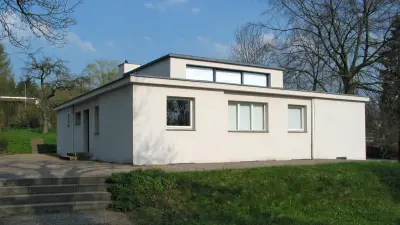
A new look

That year, Junkers hired the artist and advertising designer Friedrich Peter Drömmer, who also had close links with the Bauhaus movement. One of Drömmer’s first designs was another true first at Junkers: The “flying person” logo became a key element of Junkers’ visual identity over the next decades.
With this design, Junkers consolidated the company’s brand identity across the entire group and established a uniform image. As head of advertising, Drömmer went further and standardized all of the company’s advertising materials, coming up with a modern, Bauhaus-based design focusing on objectivity and clear geometric forms.
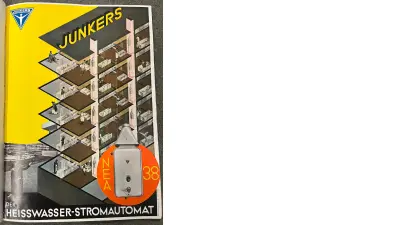
When the Bauhaus school moved to Dessau in 1925, Hugo Junkers and his employees were delighted. One Junkers employee summed things up nicely: “Here at Junkers, we got involved straight away of course. Bauhaus meant progress and thinking of new ideas. That was what we were all about too.” The highlight of the partnership between Junkers and the Bauhaus school was the “Gas and Water” exhibition, which took place in Berlin in 1929. Junkers commissioned the Bauhaus school with the design of a stand measuring 200 square meters. Besides the trade audience, the exhibition attracted plenty of private visitors and therefore potential customers. This was a challenge when it came to the exhibition design. Junkers wanted to showcase the products in day-to-day use, as essential everyday items at work, in the home, and for keeping things clean. The first room in the exhibition illustrated the use of gas-powered devices for heating and the efficiency of hot-water heaters. Both systems made lives significantly easier at home, removing the need to haul coal from the coal store and heat water on an open fire.
All in all, the 40-meter-long, 5-meter-wide stand impressed exhibition visitors. The stand design included large-format photos, a light and color concept, a mixture of room designs, and a small auditorium for short films. To give the company’s employees a taste of the exhibition, Junkers published a special issue of its employee newspaper, “Junkers Nachrichten”. Through photos and detailed descriptions of the spaces, employees could also experience this landmark event.
Collaboration between Junkers and the Bauhaus school came to an end during the global economic crisis. Hugo Junkers and his group of companies fell into financial difficulties, with Junkers opting to sell his manufacturing operations for gas devices to Bosch in 1932. The Bauhaus school was also forced to close its doors in Dessau one year later — but not before the Bauhaus ideal had spread all over the world.
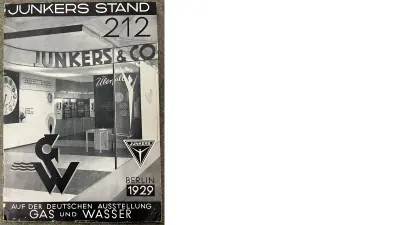
Design is more than just the visuals
Right from the outset, Bauhaus was all about bringing together art and handcraft. Nowadays, design developments go even further. The most important element, alongside design, is the user and ensuring that using a product, system, or service is a positive experience. That is why Bosch set up the User Experience corporate department in 2012 and has since elevated the design and functionality of all its products, services, and software to a new and uniform standard.
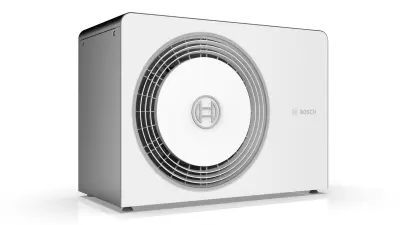
Bosch constantly finds new ways to demonstrate the long association between design and innovative technology. Bosch Home Comfort paid close attention in the development of the new Compress 5800i/6800i air/water heat pumps, designing the systems to be sound-optimized from the ground up and therefore ideal for densely populated areas. The systems operate using the natural refrigerant R290 (propane), making them a significantly more eco-friendly way of providing heat. Thanks to simple connectivity functions, the heat pumps can be monitored and maintained remotely and operated intuitively via smartphones and tablets. The modern design was also a favorite of the Red Dot Design Award panel, who honored the heat pumps with the Red Dot Award: Product Design in 2023. The panel highlighted the “pure form factor with the sleek front sides, which allow the heat pumps to fit in perfectly with the urban environment.”
Author: Carmen Senger

